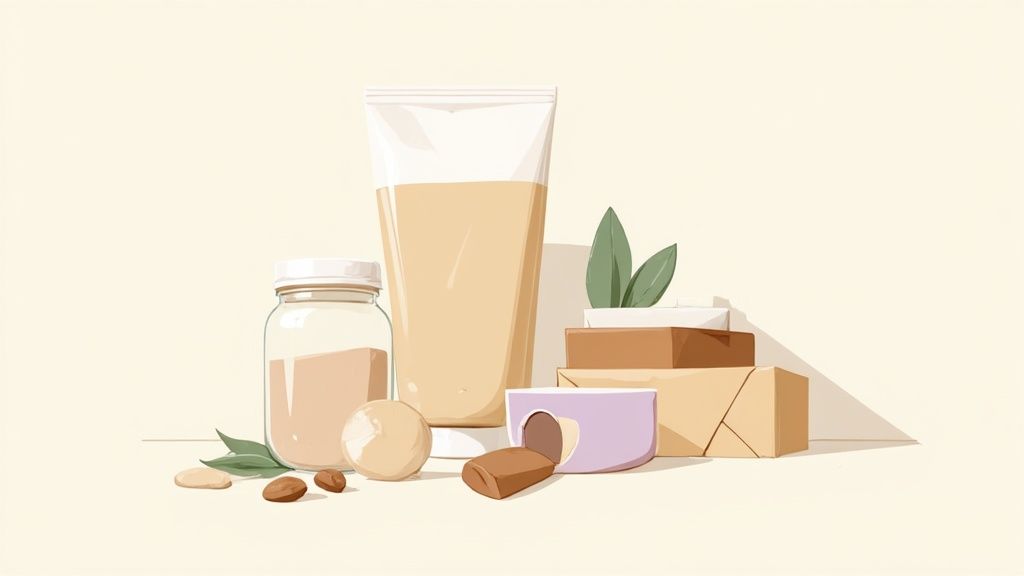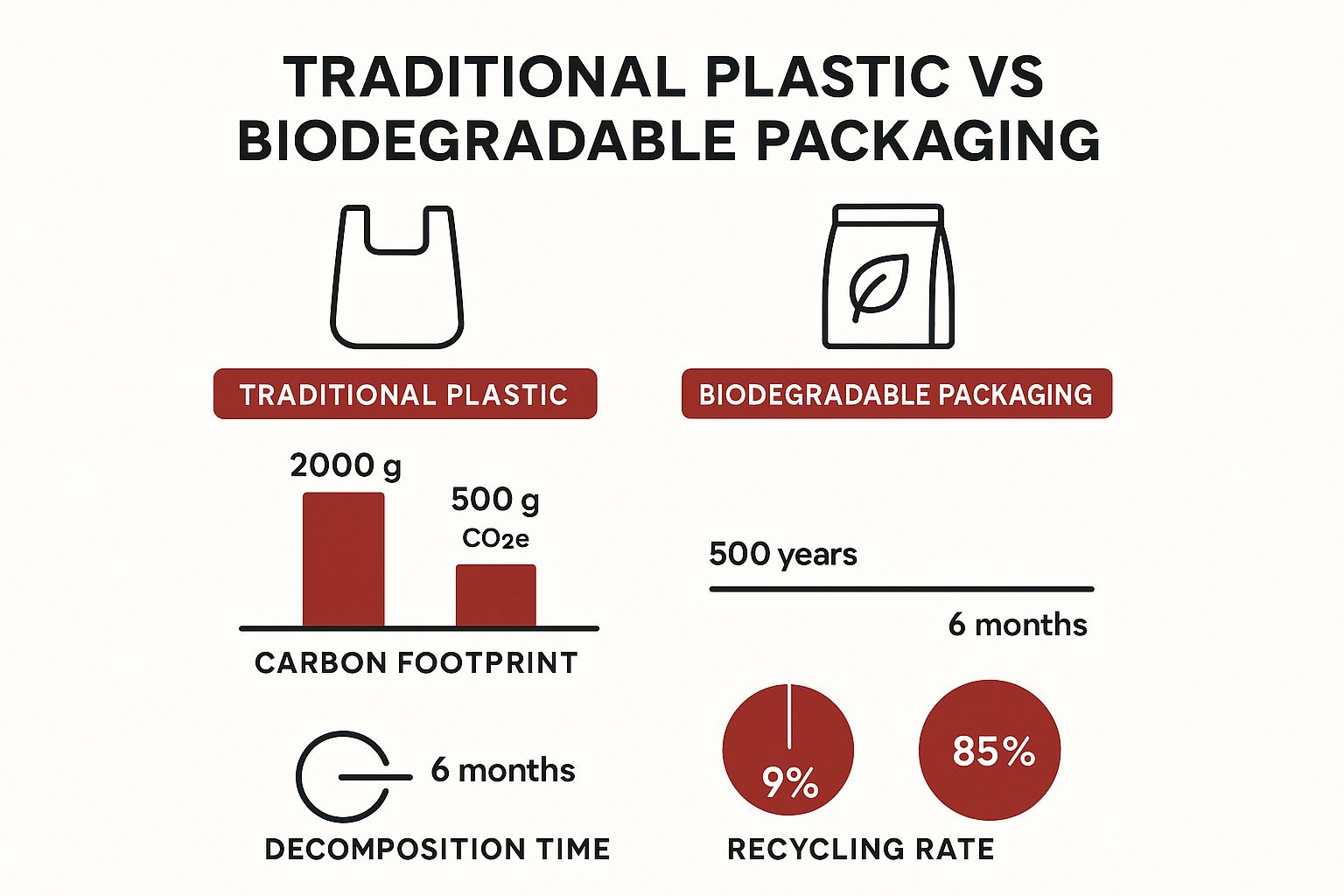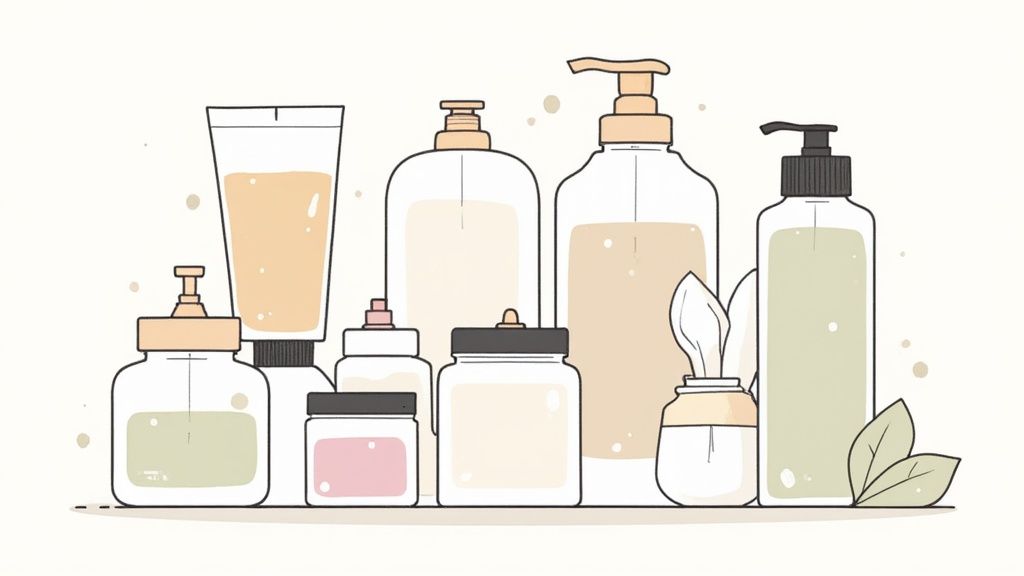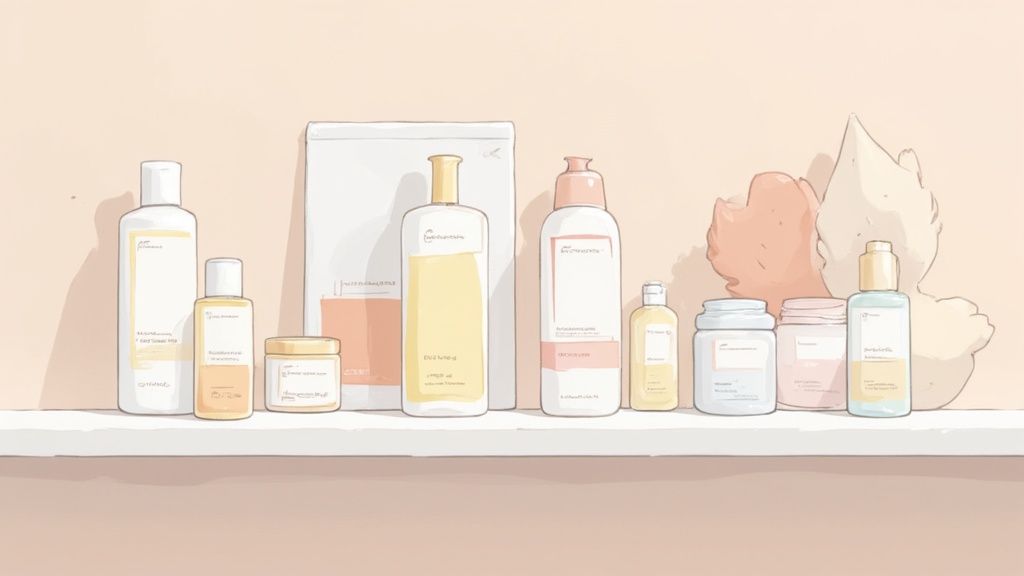When we talk about sustainable cosmetics packaging, we’re talking about a massive, necessary shift away from the single-use plastics we’re all used to. The goal is to move toward materials that are recycled, recyclable, reusable, or compostable. It’s about committing to a different way of thinking—designing packaging with its entire life story in mind, from creation to disposal.
Why Sustainable Packaging Is No Longer Optional
The conversation around eco-friendly packaging in beauty has definitely moved out of the niche "granola" category and into the mainstream. It’s a core business reality now. Think about it: traditional packaging is basically a one-way ticket to the trash can. It gets used once and then tossed, feeding into the staggering 120 billion units of packaging the global cosmetics industry pumps out every single year. Yikes.
Sustainable packaging, on the other hand, is like a durable, all-access pass that you can use over and over, minimizing waste and keeping its value.
This isn’t just a feel-good idea; it’s being driven by some powerful forces that brands simply can't afford to ignore anymore. The biggest driver? Us. Consumers. We're asking for transparency and demanding accountability from the brands we support. Today’s shoppers are way more informed and environmentally conscious than ever before.
The market is reflecting this loud and clear. The global sustainable packaging market is on track to hit a massive $552.5 billion by 2033. That growth is being fueled by our choices, with over 54% of consumers saying they intentionally pick products that come in eco-friendly packaging.
The Forces Driving Industry Change
A few key things are really speeding up this transition:
- Heightened Consumer Scrutiny: We’re all actively looking for brands that share our values. If a company shows a real, genuine commitment to the planet, we're way more likely to give them our business.
- Environmental Accountability: The heartbreaking images of plastic pollution in our oceans and piling up in landfills have put immense pressure on every industry to clean up their act and stop contributing to the crisis.
- Regulatory Pressures: It's not just consumers, either. Governments around the world are getting stricter about single-use plastics and waste, forcing companies to get innovative or face the consequences.
As the beauty industry makes this huge move, it's worth noting the broader sustainability strategies and trends in the retail industry that are shaping how products are presented and what we choose to buy.
Ultimately, this whole movement is about so much more than just switching from plastic to paper. It’s about completely rethinking how we design, use, and dispose of the products we love. This guide will walk you through it all—from understanding the problem to discovering the seriously cool solutions that are shaping a cleaner, more responsible future for beauty.
The True Cost of Conventional Cosmetics Packaging

To really get why we’re so passionate about sustainable cosmetics packaging, we first have to look at the alternative. And honestly, it’s pretty grim. Let’s track the journey of a typical plastic foundation bottle or lipstick tube. It’s a trip that starts deep in the earth and usually ends in our oceans or landfills, leaving a trail of destruction every step of the way.
It all begins with crude oil. Extracting this fossil fuel and then refining it into plastic pellets is a super energy-hungry process that pumps a ton of carbon into the atmosphere, directly fueling climate change. From there, those little pellets are melted, molded, and shipped to factories across the globe—adding even more to their carbon footprint.
Once it’s a shiny new container, it gets filled, sold, and used. That’s where its main job ends, but its environmental impact is just getting started. What happens next is where the story gets really ugly.
From Shelf to Landfill
After a few months, that plastic bottle is empty. We might toss it into the recycling bin, feeling pretty good about ourselves, but the reality is just… sad. Globally, a whopping 91% of all plastic is not recycled. Cosmetic packaging is often made from a weird mix of materials, which makes it nearly impossible for most recycling centers to actually process.
So, where does it all go? Most of it gets hauled off to a landfill, where it will just sit. For centuries.
A single plastic bottle can take up to 450 years to break down. It will outlive you, your kids, and your grandkids, slowly crumbling into toxic little pieces.
As the plastic breaks down, it releases microplastics—tiny fragments that seep into our soil and water. These particles contaminate entire ecosystems, get eaten by wildlife, and eventually, make their way right back to us through our food chain. It’s a vicious cycle.
The Oceanic Endpoint
A huge amount of this plastic junk doesn't even make it to a landfill. An estimated 8 million tons of plastic gets dumped into our oceans every single year, creating massive floating islands of trash. When you consider that the beauty industry churns out over 120 billion units of packaging annually, you can see how big its contribution to this crisis is.
This isn’t just about waste. It's about a "take, make, dispose" system that is fundamentally broken. Conventional packaging is designed to be used for a short time and then thrown away, but its consequences last practically forever. Seeing the true cost makes it crystal clear why the shift to sustainable, responsible packaging isn’t just a trend—it's something we absolutely have to do for the health of our planet.
Exploring Innovative Eco-Friendly Materials
The hunt for truly sustainable cosmetic packaging has kicked off a major creative boom in the beauty world. Brands are finally looking beyond cheap, easy plastic and embracing a new generation of materials designed to be way kinder to the planet. This isn't just about looking good, either—it's a real shift in how we think about creating, using, and eventually returning our packaging back to the earth.
Let's be real, there's a financial push, too. The global cosmetic packaging market hit $36.16 billion in 2024 and is expected to jump to a massive $56.15 billion by 2034. That growth is almost entirely thanks to shoppers like us demanding better options, like glass, bamboo, and recycled plastics.
This image really drives the point home, showing the huge difference between old-school plastic and the newer biodegradable stuff.

The numbers don't lie. Biodegradable materials slash carbon emissions and break down hundreds of times faster, all while being way more recyclable. It's a no-brainer.
The Classics Reimagined: Glass and Aluminum
Glass and aluminum are the undisputed champs of recycling. Unlike plastic, which gets weaker every time it's reprocessed, these two can be recycled over and over and over again without ever losing their quality. Think of it like this: an aluminum can could be melted down and turned into a new container forever.
They aren't perfect, though. Making them from scratch takes a ton of energy. That's why using post-consumer recycled (PCR) glass and aluminum is so important—it drastically cuts down on the energy needed to produce them. You can dive deeper into how brands are using PCR materials in our guide to eco-friendly packaging in cosmetics.
The Rise of Plant-Based Solutions
Now for the really cool stuff. The industry is getting creative with materials that are literally grown from the ground up. These biomaterials are opening up exciting possibilities for packaging that’s both high-performing and completely biodegradable.
Here are a few of the most exciting ones popping up:
- Bamboo: It’s a super fast-growing grass that doesn’t need pesticides and grows back quickly, making it an amazing renewable resource for things like caps and jars.
- Mushroom Packaging (Mycelium): Seriously, it's grown! This material uses agricultural waste and mushroom roots (the mycelium) and can be molded into any shape. Best part? It's 100% home-compostable and disappears in just a few weeks.
- Seaweed and Algae: These ocean-based materials can be turned into bioplastics that are compostable (and sometimes even edible!), offering a solution that can actually help clean up our waterways.
- Cornstarch PLA (Polylactic Acid): Made from fermented plant starch, PLA looks and feels a lot like plastic but is commercially compostable, meaning it breaks down properly in an industrial facility.
The whole point of these materials is to create packaging that works with nature’s cycles, not against them. Instead of leaving behind trash for centuries, this packaging is designed to break down and go back to the soil, actually enriching it instead of polluting it.
Comparing Sustainable Packaging Materials
Feeling a little overwhelmed by the options? It's a lot to take in. Here's a quick cheat sheet to help make sense of the most common materials.
| Material | Key Benefit | Potential Drawback | Best For |
|---|---|---|---|
| Recycled Glass | Infinitely recyclable without quality loss; feels premium. | Heavier weight increases shipping emissions; can break. | Skincare jars, foundation bottles, luxury items. |
| Aluminum | Lightweight and infinitely recyclable; durable. | Can be energy-intensive to produce from virgin ore. | Deodorant tubes, lip balm tins, refillable containers. |
| Bamboo | Highly renewable and fast-growing; biodegradable. | Not all bamboo packaging is 100% plastic-free (check for liners). | Compacts, caps, outer casings for lipstick tubes. |
| Mushroom (Mycelium) | 100% home compostable; custom-molded protective shapes. | Not waterproof; best for secondary or protective packaging. | Molded inserts for shipping, gift sets. |
| Cornstarch PLA | Looks and feels like plastic but is biodegradable. | Requires industrial composting facilities to break down properly. | Clear windows on boxes, lightweight jars. |
At the end of the day, picking the right material is a balancing act. A brand has to think about what the product needs, the full lifecycle of the material, and what kind of recycling or composting is actually available to their customers. There’s no single "perfect" material, but having so many innovative options means brands can finally start making smarter, kinder choices for every single product.
Designing for a Circular Beauty Economy

Picking the right materials is a huge first step, but real sustainability means we have to think bigger. It's about designing packaging not for a one-way trip to the landfill, but for a continuous loop of use and reuse. This is the heart of the circular economy.
It means shifting away from the old "take, make, dispose" habit and building systems that keep materials in play for as long as humanly possible.
Think of it this way: your standard beauty product is like a single-use coffee cup—used once and then tossed. Circular design is more like a beautiful, durable thermos you refill every morning. The original container is designed to be kept, valued, and used again and again, which cuts out the daily waste entirely. It’s not just about making less trash; it’s about changing how we think about the things we buy.
The Power of Refillable and Reusable Systems
Refillable and reusable packaging is really the foundation of a circular beauty world. The idea is simple: customers buy a gorgeous, permanent container once, and from then on, they just purchase refills. These refills usually come in minimal, lightweight, or even compostable pouches.
This approach is a total win-win. Brands shrink their environmental footprint and build incredible loyalty with customers who keep coming back. And the proof is in the numbers—sales of refillable makeup shot up by 364% in the first half of 2022 alone. It’s clear that people are more than ready for systems that are both elegant and earth-friendly.
We’re seeing this philosophy pop up everywhere. The coffee industry, for example, is diving into innovative refillable packaging solutions that look a lot like what’s happening in beauty.
Designing for Simplicity and Recyclability
Another huge piece of the circular puzzle is designing mono-material packaging. All this means is making a container out of a single type of material. So many traditional cosmetic containers are a mashup of different plastics, metal springs, and other bits and pieces that make them an absolute nightmare for recycling facilities.
By sticking to one material—like an all-aluminum tube or an all-glass jar with a matching glass lid—brands make recycling a breeze for everyone. No need to pull apart tiny components; the whole thing can just be tossed in the right bin.
This smart design approach also includes using materials like post-consumer recycled (PCR) plastics. When we use plastic that's already had a life, we close the loop and cut down the demand for brand-new fossil fuels. To see this in action, you can read more about how Axiology tubes are now made out of PCR plastic.
At the end of the day, simple, thoughtful design is what makes sustainable packaging actually work.
How Tech Is Advancing Greener Packaging
The big push for sustainable cosmetics packaging isn't just about finding new, earthy materials. A huge part of the solution is actually happening on our screens, thanks to some seriously smart digital tools.
Technology is stepping in to solve some of the toughest challenges in creating greener packaging. It's making the whole process—from initial design to end-of-life recycling—smarter, faster, and way more efficient. Think of it as a sustainability co-pilot, spotting opportunities to cut down on materials or improve recycling in ways we couldn’t before.
AI-Powered Sustainable Design
One of the coolest developments is how artificial intelligence is being used to design packaging. AI programs can crunch the numbers on thousands of design options at once, figuring out the perfect shape, thickness, and structure to protect a product using the absolute minimum amount of material.
This means we get packaging that’s both stronger and lighter, which slashes a brand's carbon footprint right from the get-go. AI is also helping brands choose the best sustainable materials for the job, pushing us closer to a real circular economy. If you want to dive deeper, you can check out the full research on the plastic-free cosmetic packaging market.
Innovations in Recycling and Sorting
Tech is also revolutionizing what happens to your empty containers after you’ve used the last drop. New recycling methods are giving a second life to materials that, until recently, were just considered trash.
- Chemical Recycling: This process is a total game-changer. It breaks down tricky mixed plastics into their original chemical building blocks. Those blocks can then be used to make brand-new, high-quality plastics, finally closing the loop on hard-to-recycle cosmetic tubes and tubs.
- Digital Watermarks: Picture a tiny, invisible barcode printed all over a package. It’s undetectable to us, but scanners at recycling facilities can read it instantly. This tells the sorting machines exactly what the material is and how to handle it, which could dramatically boost our recycling rates.
These aren't just far-off ideas; they're creating real solutions right now. By making recycling smarter and more effective, technology is making sure more materials get recovered instead of ending up in landfills and oceans.
The future of sustainable packaging is being built with these powerful tools. They give us the precision needed to design waste out of the system from the very beginning. It’s a pretty clear sign that the best path forward is a combination of natural, earth-friendly materials and brilliant technology.
Making Smart and Sustainable Choices
Okay, so now you know a bit more about the materials and ideas behind sustainable beauty packaging. That’s the first step. The next, and way more important step, is actually putting that knowledge to use. Your choices at the checkout counter send a huge message to the beauty industry about what you care about. It makes you part of the solution.
Let’s be real, walking down the beauty aisle can be a total headache, especially with all the confusing marketing claims. The trick is to get good at spotting genuine effort versus slick "greenwashing." This means looking past vague words like "eco-friendly" and digging for actual, specific info.
Before you buy, try to get in the habit of asking a few key questions. Does the brand tell you exactly how to dispose of the packaging? Is it made from just one material, which makes recycling way easier? Do they have refill options to help you buy less in the first place?
Your Sustainable Shopping Checklist
To make things a little less complicated, here’s a quick guide to help you vet products. It’s an easy way to back brands that are actually walking the walk.
- Check the Symbols: Look for recycling symbols you recognize and legit certifications like FSC (Forest Stewardship Council) for any paper or cardboard. Knowing these symbols helps you figure out if the packaging can even be processed where you live.
- Spot Greenwashing: Be skeptical of packaging that’s all earthy colors and pretty nature pictures but doesn't offer any real substance. True sustainability is about being transparent, not just having a clever marketing team.
- Prioritize Refills and Reusables: Whenever you can, choose products that come in refillable containers. This is honestly one of the best ways to slash single-use waste. To learn more about this whole philosophy, check out our guide on what zero waste really means.
By voting with your wallet, you’re helping create a market where sustainability isn't just a trend—it’s the standard. Your thoughtful purchases are a powerful force, pushing the entire industry toward a cleaner, more responsible future. Every smart choice adds up, proving that what we demand as consumers can, and does, create real change.
Still Have Questions? We've Got Answers.

Diving into sustainable packaging can feel a bit overwhelming, we get it. So, let's clear up a few of the most common questions that pop up.
Is Compostable Packaging Always Better Than Recyclable?
Not necessarily, and this one trips a lot of people up. The "better" option really boils down to what your local waste management can actually handle.
Compostable packaging is a huge win—but only if it makes it to an industrial composting facility. If it gets tossed in a landfill, it can’t break down the way it’s designed to. In many places, a widely recycled material like glass or aluminum is actually the more reliable, earth-friendly choice.
What Is Greenwashing and How Can I Spot It?
Greenwashing is just a sneaky marketing tactic where a company talks a big game about their environmental efforts but doesn't actually back it up. You can usually spot it when you see super vague, fuzzy claims like "eco-friendly" or "all-natural" without any real proof.
The good guys are all about transparency. A truly sustainable brand will give you the specifics on their materials, show off their third-party certifications (like FSC or B Corp), and provide crystal-clear instructions on how to recycle or compost their packaging.
Are Refillable Cosmetics Actually Hygienic?
Yes, absolutely—as long as they're designed with care. The best refillable systems use sealed cartridges or pods that keep the product totally protected from contamination.
And for the kind you pour yourself? The secret is simple: just wash and completely dry the original container before you add the new product. Any brand that’s serious about refills will give you easy-to-follow instructions to make sure the whole process is safe and clean.
At Axiology, we're all about making choices that are kind to you and the planet. Come explore our collection of plastic-free, zero-waste makeup and see just how gorgeous sustainability can be. Visit us at AxiologyBeauty.com.





